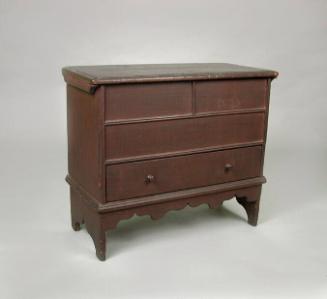Chest with Drawer
Furniture MakerMade by
Unknown
Date1700-1740
MediumTulip poplar
DimensionsPrimary Dimensions (overall height x width x depth): 18 x 21 3/4 x 9 3/16in. (45.7 x 55.2 x 23.3cm)
ClassificationsFurniture
Credit LineBequest of George Dudley Seymour
Object number1945.1.1071
DescriptionDiminutive tulip poplar chest with drawer in the William and Mary, or early baroque, style. The chest with drawer has a 7 3/4 inch deep chest, concealed behind three false drawers arranged two overo ne, over one full-width drawer. The top (replaced) has ovolo, or thumbnail, molding on the front and sides. A hinge (replaced), consisting of a tapered piece of wood, extends from front to back at each side on the underside of the top. Each drawer is surrounded by projecting double astragal molding, or double half-circle molding. Below the full-width drawer is a skirt with a shaped lower edge, consisting of a cyma curve, or S-curve, with a reverse cyma curve, flanked by a short horizontal, then a cyma curve and a reverse cyma curve. The sides of the case extend down to form a skirt and feet at the sides only. The skirt has a shaped lwoer edge, consisting of a large cyma curve and reverse cyma curve. Hardware on the chest of drawers consists of two round wooden knobs on the full-width drawer. The chest is painted with an overall red wash.
Condition: The top of the chest and hinges are replaced. The left hinge is loose, and both hinge pins are loose. The bottom of the drawer is replaced.
Design and Construction Details: The top (replaced) is constructed of a single board. The chestnut hinges (replaced, the left one is loose) are nailed to the underside of the lid. Each hinge has a round hole at the back that pivots on a cylindrical hinge pin that extends into a tenon at the top back corner at each side of the chest. The sides of the chest fit into a rabbet in each end of the front and back board of the case; these joints are nailed from the front and back corners. The back is constructed of two boards, one forming the back of the chest and one covering the back of the drawer. The front is constructed of a board that forms the front of the chest and false drawers. The bottom of the chest is held in place with nails through the lower front and back of the chest. The double astragal molding that outlines the drawers is nailed in place. The skirt is nailed into a rabbet in the front edge of each side of the case.
Drawer Construction. The false and true drawers are outlined with double astragal molding nailed to the case. The drawer runners are nailed to the interior bottom sides of the case; each drawer runner is widest at the top edge and has a sharp taper down to the bottom. The drawer front is solid. The sides of the drawer are joined with a single nailed dovetail to the front and back of the drawer. The bottom (replaced) slides into a groove in the lower sides of the drawer, and is nailed through the back.
Condition: The top of the chest and hinges are replaced. The left hinge is loose, and both hinge pins are loose. The bottom of the drawer is replaced.
Design and Construction Details: The top (replaced) is constructed of a single board. The chestnut hinges (replaced, the left one is loose) are nailed to the underside of the lid. Each hinge has a round hole at the back that pivots on a cylindrical hinge pin that extends into a tenon at the top back corner at each side of the chest. The sides of the chest fit into a rabbet in each end of the front and back board of the case; these joints are nailed from the front and back corners. The back is constructed of two boards, one forming the back of the chest and one covering the back of the drawer. The front is constructed of a board that forms the front of the chest and false drawers. The bottom of the chest is held in place with nails through the lower front and back of the chest. The double astragal molding that outlines the drawers is nailed in place. The skirt is nailed into a rabbet in the front edge of each side of the case.
Drawer Construction. The false and true drawers are outlined with double astragal molding nailed to the case. The drawer runners are nailed to the interior bottom sides of the case; each drawer runner is widest at the top edge and has a sharp taper down to the bottom. The drawer front is solid. The sides of the drawer are joined with a single nailed dovetail to the front and back of the drawer. The bottom (replaced) slides into a groove in the lower sides of the drawer, and is nailed through the back.
Status
Not on view










